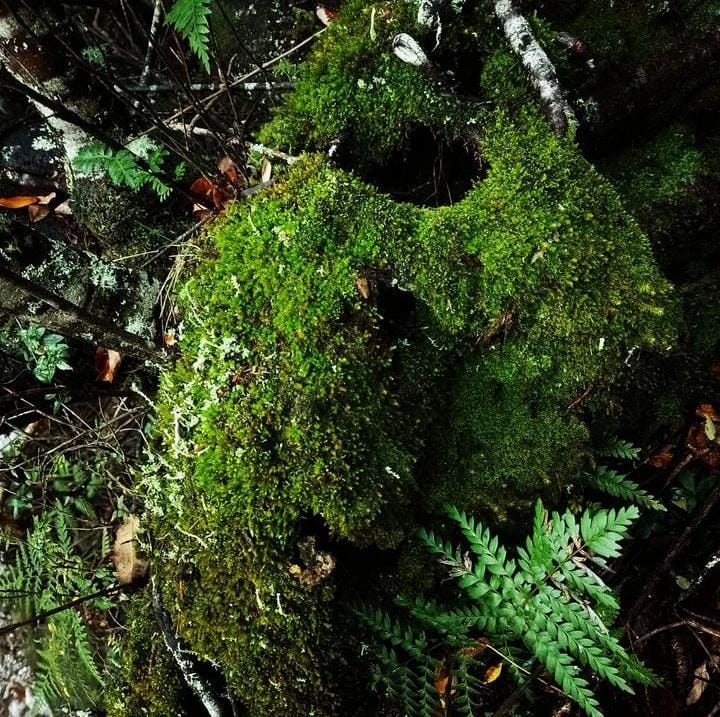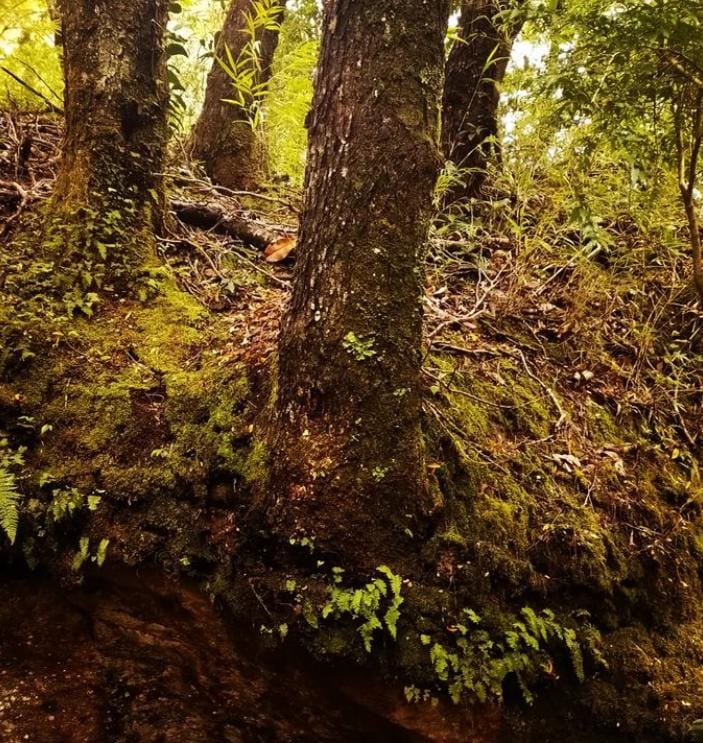The pressing and urgent drive that inhabits within the search for the understanding and comprehension of the nature of the world is so deeply rooted in the human being that perhaps only Ahrimanic radiations [1] (which, according to Steiner, correspond to influences emanating from forces that propel materialism, mechanization, and the fragmentation of human thought) could give shape to the blocks that construct a thick barrier of mental noise, so densely colonized by distractions and polluting entities, diverting man from his exploration of the innate and fundamentally religious dimensions of his being; leading him astray from his external crusade, a reflection of the internal inquiries of his soul. The incarnation of Ahriman, ever-present and as inevitable as humanity itself, may be confronted through the journey into the ambuscade. By contemplating the mysterium tremendum, absorbed by the apophatic paths of the forest, it becomes possible to access the heterogeneous storms that shake the soul, causing it the necessary distress to break free from the delusions that cloud the vision towards deeper layers.
In the Homo religiosus, and according to the different degrees of exposure to the pollutions that penetrate and oversaturate the various layers covering the realms of the profane, there resides a natural inclination toward the sacred and the transcendent, inherent to the human condition and manifest throughout history; a constant search for meaning in existence and the desire to transcend the boundaries of the mundane (a search expressed through ritual practices, religious myths, and symbols) and the eternal iron laws. Within him also resides the experience of the sacred as a reality that transcends and transforms the profane and the everyday, the pursuit of participation in timeless and eternal realities through rituals and ceremonies that connect him to the cosmic and divine order, along with a constant revaluation of the sacred in contrast to the secularization and loss of the transcendent in modern society.
The human being roams almost instinctively through the world in search of hierophanies, seeking immensity even in spaces where the tremendous, the awe-inspiring, the horrifying, and the reverent—in the sense of the numinous and the sacred—are not conventionally present. But there is not only the search for understanding the nature of the world: the search for the comprehension of the world of nature unfolds before the human, unfurling before his senses like a papyroplexity, reversing to reveal the angles of its many folds, hypnotically calling him to immerse himself in realms where uncertainty and heterogeneity reign.
The initiatory wanderer, driven by this search—visceral-labyrinthine and acephalic, yet also containing non-acephalic aspects—perhaps not in the form of the emergence of motivation to ambush himself and be engulfed by the damp, painful, and thorny embrace of the forest, but rather through thought and reflection on the tracing of his own path in the alchemical quest (his part of the Magnum Opus—his own transmutation after his annihilation in the crucible of the forest), throws himself into the exploration of the various domains where the wild resides—or, more precisely, where the civilized does not reside, for the civilized is but a contraction within the wild—to unveil, experience, and witness the hierophanies that may reveal themselves before him, hierophanies that may even unfold in defiance of reality itself.
***
The Valdivian temperate forest ecosystem, a highly biodiverse ecosystem located in the temperate rainforests of southern Chile and Argentina, features dense and lush vegetation, with large trees (e.g., Nothofagus dombeyi, Laureliopsis philippiana, Weinmannia trichosperma, Fitzroya cupressoides, etc.), as well as tree ferns, shrubs, and underbrush that contribute to the diversity of the forest canopy. It also exhibits a characteristic temperate rainforest climate, with abundant rainfall throughout the year. This extremely high humidity and precipitation favor the opulent growth of vegetation and create ideal conditions for the occupation of a particular ecological niche by bryophytes.[2]

The predominantly green mosses, distinctive ornaments scattered throughout the Valdivian forest-clad ecoregion, carpet the various surfaces that can be found within this ecosystem. Their millions of strands weave together into a soft and delicate tapestry that captures water in its recesses, forming the cold, damp, chlorophyllic carpet of Prakriti. These shapeless, nebulous patches of moss, guided by the impulse of the archetypal plan contained in Purusha—the universal intellect that permeates all aspects of Prakriti—offer, with their simple structures, a moist and spongy bed for seeds and tree sprouts to settle on the mantle of rocky blocks and later support the celestial vault. This carpet not only becomes the master builder of a vertical ecosystem, allowing larger plants, such as trees, to root and rise toward the heavens, but also has the capacity to sustain the lungs of the evergreen forest. Tiny seeds, carried by the wind or by birds, find a foothold within the weave of the rhizoids—an alchemical metamorphosis from a modest chapel into an imposing cathedral of titanic pillars where the Numen resides.
Establishing their dominion in the available spaces within the intricate and hostile assemblies of granitic rock walls—rough and cracked like the faces of deities fallen from grace after the Titanomachy—in the harsh concavities of the rocky visage of the chthonic garment of the ancient goddess, where one would expect the landscape, given the difficulty of the substrate, to rise as a natural fortress against the colonization of trees and shrubs, bryophytes emerge as artisans who, though discreet and rudimentary compared to other species endowed with more complex anatomical structures, are essentially vital for the establishment of the hanging pillars of the cellulose cathedrals, perhaps hierophanies, that seem to defy both logic and gravity. In this defiance of laws, in the introduction of Chaos and the frontal conflict with the designs of gravity, there is also harmony with the Whole-ness, and the blood of Gaia ascends through the candelabras juxtaposed on the pillars of rigor and mercy: overflowing, creative compassion, but also the corrective power necessary to establish boundaries, order the chaos, and maintain balance in the Cosmos.
Immersed in the shadowy embrace of the evergreen weave, the alchemical wanderer confronts not only the external forces that batter his body, but the internal forces that drag him into the darkest and most primitive depths of his soul. The portion of the biosphere that stretches before him, in its apparent chaos and primordial violence, is in fact a manifestation of an underlying order that escapes the untrained eye. The mosses and lichens that cover the rocks, in addition to decorating the landscape, are silent guardians of a process of transmutation carried out at different levels of organization. Just as the strands of moss defy the roughness of the granitic substrate to weave upon it a living layer, the Adept must confront the hardness of his own being, allowing his consciousness to be shaped in the crucible of the conflict between light and shadow. For in the moss resides not only the substrate for the pillars of the cathedral of cellulose but also the origin of the fabric that clothes the archetypal wild one. In the wet emerald carpet that covers and intertwines and coexists with the structures of the forest, the Adept glimpses the hidden image of primordial nature, the one that lies in the dim light of the human psyche. For Jung, this archetypal wild one symbolizes the primitive part, the lower aspect of the person, the unconscious in its dangerous and regressive form. The green mantle that spreads over the edges of existence thus becomes a tangible expression of the link between consciousness and the unconscious, the connection between light and darkness, between the manifest and the unmanifest—a bridge between the material and the immaterial, between the corporeal and the ethereal. It is in this crucible of tensions that the moss rises as a silent guide toward the mysteries of Schatten, or «the Shadow.» The artisans of the pillars are also artisans of the connection with the Shadow, necessary for the process of individuation, which seeks wholeness and the integration of all aspects of being—a refuge where the Adept confronts the roughness of his untamed essence: the portal to the irrational, to that abyss where the psyche is stripped bare and faces its own darkness. The integrity of the self is not found in the repression of the dark but in the acceptance and integration of the unknown.

Venture deep into the passage drawn by the bowels of the forest, where the archetype of the wild one materializes in the Shadow and merges with the primal forces that have shaped existence since ancient times. The Adept receives the relentless reflections of the Numen, but he is also mercilessly lashed by the blows of heterogeneity, which erode his being from the conventions that bind him to the homogeneous. In the forest’s depths, the laws that govern the human world dissolve miserably, and the lights of civilization do not penetrate. What in the civitas we regard as rigid and immutable is revealed in this wild space as transitory, mutable, nothing more than a simple veil that covers and disguises the vast Reality, making existence more bearable. The chthonic forces, symbolized by the rugged and seemingly inhospitable landscape, arise before the Initiate as a representation of the primordial maternity of Gaia, whose blood silently flows through the hidden arteries and veins of the Earth, raising the pillars of the living cathedrals that defy the pull of the very Earth. The bryophytes, modest colonizers of the mineral world, are living metaphors of the alchemical process that transforms the primitive into the sublime.
In the forest passage, exhausted and lost among the elements, defenseless without the frameworks and structures provided by the safety of the civitas, it is then that Anarchy—the abyss of liberation from the bonds imposed by civilization—reveals itself to the alchemical wanderer, now the architect of his own ruin, pushing him against the waves that shake his being so that he may be shattered by Reality and reborn from the pulsating mysteries of the Nigredo, the organic anvil where the spirit is forged through blows and refined, freed, and stripped of its impurities by the fire of suffering and the confrontation with the unknown. For true transformation is not achieved through evasion or denial, but through total immersion in the mysteries of being and the Cosmos.
Notes.
1. Ahrimanic radiations can manifest in various ways: the promotion of the belief that only materialistic and empirical science can provide true knowledge, leading humanity to consider mechanistic explanations of the universe as absolute; superstitious attitudes toward science, blindly accepting scientific knowledge without questioning its limited and illusory nature; a narrow worldview confined to what can be measured and quantified, focusing exclusively on tangible and rational aspects; the formation of individuals highly competent in technical and utilitarian terms but disconnected from other dimensions; and the acceptance of scientific and technological constructs as the ultimate reality, rather than recognizing them as useful yet limited tools, alienating true human nature.
2. Bryophytes are small terrestrial non-vascular plants, lacking specialized conducting tissues for the transport of water and nutrients (they do not possess true roots, stems, or leaves), and grow in moist, shaded environments. They reproduce through spores and exhibit an alternation of generations, with a dominant gametophytic phase. They have a haplodiplobiontic life cycle, with a haploid phase (gametophyte) and a diploid phase (sporophyte).
